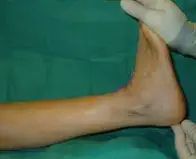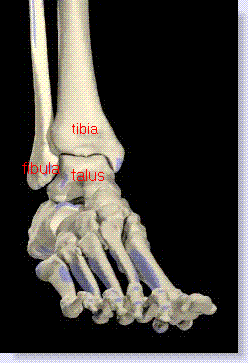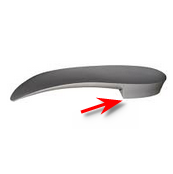equinus
AUTHOR: Marc Mitnick DPM home --> equinusWHAT IS AN EQUINUS DEFORMITY
An ankle equinus deformity is not a medical condition as such but is more reflective of a condition where the foot is unable to dorsiflex, or bend upwards at the level of the ankle joint. As a result of this condition, there are many foot and ankle problems that can occur. Patients rarely present to the office complaining of a restricted range of motion in the ankle, but rather present with one or more of the problems that this condition can create.
The problem is defined as insufficient dorsiflexion in the ankle in order for normal gait to occur. This lack of dorsiflexion then requires the lower limb to compensate in some capacity to make up for this lack of motion.

|
There are various opinions as to what is normal ankle dorsiflexion but in general 10 degrees or more dorsiflexion is considered normal. This amount of ankle motion has to occur with the knee joint extended (locked).
It is generally accepted that dorsiflexion between 5-10 degrees is associated with minimal foot and leg compensation during gait, while dorsiflexion below five degrees is associated with significant gait compensation as well as an increase of pressure on the forefoot which increases the risk of forefoot pathology. The picture to the right reveals zero degrees of dorsiflexion.
WHAT CAUSES AN EQUINUS DEFORMITY
There are a few different ways to classify equinus based on the causative factors. Some of these classifications have become complicated. Thus it is easier to classify this problem based on either osseus (bone) or soft tissue restrictions.
SOFT TISSUE ORIGINS
- The most common cause is known as gastroc-soleus equinus. This results from a shortening of the co-joined tendon of the gastrocnemius and soleus muscles as they come together to form the Achilles tendon.
- Damage to the Achilles tendon from either trauma or collagen disease may also cause a limitation of ankle motion.
OSSEUS ORIGINS
- bone spurs arising from the tibia and fibula bones of the leg
- abnormal alignment of tibia and fibula bones as they attach to each other at the level of the ankle joint
- bone spurs on the talus bone, which is the foot bone that the tibia and fibula bone “hinge” to, may also cause an equinus deformity.

|
EFFECTS OF ANKLE EQUINUS ON THE GAIT CYCLE
The importance of the ability of the foot to dorsiflex relative to the leg occurs during what is known as the stance phase of gait and the swing phase of gait.
In gait, when the heel hits the ground, the body then moves over the foot, and the ankle joint has to be able to dorsiflex in preparation for propulsion where the foot propels the body forward. If there is not enough dorsiflexion in the ankle, at this stage, then there is excessive pressure exerted on the forefoot and this can lead to pathology.
After the foot propels the body forward, the foot itself then has to swing forward while weight is being put on the other foot. In order for the foot to swing forward, dorsiflexion of the foot relative to the leg has to occur in order to avoid dragging the toes on the ground.
In the above situations, if there is not adequate dorsiflexion occurring at the level, the body then has to compensate for this deficiency. If the body is unable to compensate there will be a shortened gait, or limitation in stride. If compensation does occur it will happen in the joints either in the foot itself or the joints above the ankle.
Above the ankle, compensation may result in a hyperextension of the knee which is increased motion in the knee joint, or compensation may also occur at the level of the hips which result in over flexion of the hip joint. Although this compensation at the knee or hip joint may allow the body to overcome the limited ankle motion, this may result in knee pathology or even lower back and hip issues.
If the foot is called upon to carry the bulk of compensation, it occurs in two ways. One is early heel rise, where the heel lifts up before the foot is firmly planted on the ground, while the other means is a flattening of the arch which includes calcaneal eversion (heel bending outward). Heel eversion lessens the strain on the Achilles tendon. A number of foot pathologies may develop, including all of the following:
- metatarsalgia
- calluses on the forefoot
- ulcers
- midtarsal arthritis
- pronation
- hallux valgus (bunions)
- hammertoes
- early heel rise leading to toe walking
- shin splints and leg cramps due to over compensation of anterior leg muscles
- ankle instability
WHAT IS THE TREATMENT FOR AN EQUINUS DEFORMITY
There are various treatments for an equinus deformity ranging from conservative care to surgical care. The goal of all treatments is to try and maintain a relative range of motion within the ankle joint while minimizing any compensation in the foot or leg.
conservative treatment
Stretching People continuously mention stretching as a means to increase motion in the ankle joint. The problem is that there is a diminishing rate of return as you age. Essentially stretching exercises are truly effective in ages up to adolescence. In this age group, stretching along with perhaps serial casting (in toe walkers) can be very beneficial.
Although stretching of the Achilles tendon is usually recommended in adults, the amount of increased range of motion within the ankle joint is usually minimal. However, even a small increase in ankle motion may be enough to be the difference between pain and no pain. Suffice it to say that in an adult, stretching is usually only one part of the equation in trying to negate the effect of a tight heel cord. Keep in mind, stretching will not be of much help in an osseus (bone) deformity.
Heel lifts For many simple equinus related problems, a simple heel lift to both heels, even though there may only be symptoms in one foot, can be very beneficial. This is particularly true for those suffering from Achilles tendonosis. Usually a one quarter inch cork heel lift is all that is needed.
Orthotics For many problems occurring in the forefoot and midfoot, an orthotic with an external rearfoot post is what is indicated to alleviate pain. Most of these problems are not only the result of an equinus condition but are also exacerbated by the excess pronation that occurs to compensate for the lack of motion in the ankle. So not only do we have to control the tight heel cord, but we also have to reduce the pronation that is occurring.

|
An orthotic with a rearfoot post means that the back portion of the orthotic which generally controls motion in the heel as the heel hits the ground, is built on the bottom of the heel portion of the orthotic. It is what is known as posting. Essentially, posting changes the angle at which the heel hits the ground. Because this external posting has thickness to it, it also acts as a heel lift thus reducing the strain on the achilles tendon while the orthotic itself reduces pronation during midstance of gait.
These types of orthotics are usually of the custom made variety because you are asking the orthotic to do a couple of functions and for that reason the measurements of the orthotic have to be exact. You will not find that in a medical grade orthotic, or any other device you may purchase in a store.
surgical treatment
In cases that do not respond to conservative care, surgical intervention has to be considered. Cases of equinus due to bone impingement have a greater tendency to not respond to conservative care and thus become surgical issues. In these cases surgical removal of the boney impingement is the indicated treatment. An Achilles lengthening procedure may also be done at this time.
There are many soft tissue procedures for Achilles tendon lengthening. The chosen procedure is the one that deals directly with the soft tissue cause of equinus as determined by the surgeon.
REFERENCES
Journal of Rehabilitation Research and Development
American College of Foot and Ankle Surgeons
Want more information? CLICK HERE


Recent Articles
-
Vitamin D impact on health
Feb 06, 23 07:17 PM
Researchers are suggesting that the effectiveness of Vitamin D in fighting and preventing disease is predicated on a persons body mass index (BMI). The thinner the person the greater the positive impa… -
Foods to speed up healing
Feb 01, 23 02:41 PM
One of the best ways to help yourself heal faster after surgery is to eat well. Getting the proper nutrition will provide your body with the essentials it needs to promote healing. Here is a suggestio… -
Cancer and Type 2 Diabetes
Jan 25, 23 04:52 PM
An article revealing that older type 2 diabetics have a higher incidence of cancer then non-diabetics. It is suggested that cancer may surpass CVD as the number one cause of death in older diabetics. -
Does glucosamine or MSM reduce arthritis pain?
Jan 22, 23 01:41 PM
A good review of the possible benefits to taking glucosamine, chondroitin or MSM for arthritis. Always beware of the possible side effects of over the counter supplements. -
shin splints
Jan 18, 23 05:12 PM
A great review on the various causes of shin splints, along with treatment options. -
Whats new in skin cancer?
Jan 15, 23 08:32 PM
A presentation of newer skin protection combinations in an effort to better protect the skin from the hazards of sun exposure. -
Causes and risk factors of warts
Jan 14, 23 05:02 PM
A good review of the causes of warts and protective measures you can take to prevent developing them. -
Do chronic wounds need to be dressed daily?
Jan 11, 23 02:18 PM
Because of supply chain shortages as well as staffing shortages particularly during the pandemic, many institutions extended the time between dressing changes for chronic wounds. Is this really the be… -
Food choices that raise your risk of type 2 diabetes
Jan 08, 23 10:07 AM
A good review of how blood sugars can become elevated and the harm that can do. Certain food groups have a tendency to raise your blood sugars and should be avoided. -
Outcome stats from Scarf bunionectomy
Jan 03, 23 03:04 PM
The Journal of Foot and Ankle Surgery recently reported a meta analysis of outcomes in 1583 Scarf bunionectomies that met their inclusion criteria. Adverse events did not seem to be any better or wors…